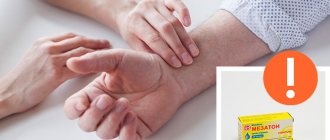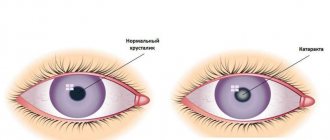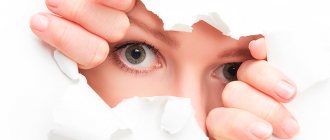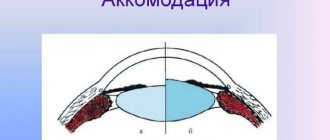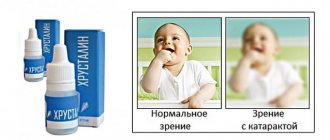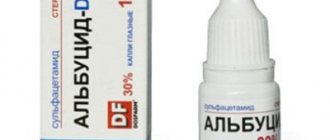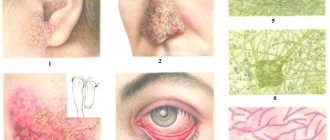Increased intraocular pressure is often observed after 40 years, but can also occur at an early age.
A persistent condition leads to the development of glaucoma, disruption of the movement of intraocular fluid and deterioration of vision, first in the periphery, then in the center.
To correct the condition, eye drops are used to lower intraocular pressure.
Their selection is made by an ophthalmologist based on diagnostic results, individual patient data, the presence of concomitant diseases, and additional medications used.
Causes of intraocular pressure
An increase in this indicator can be observed in some cases or constantly, especially in old age.
Factors that provoke increased intraocular pressure are:
- stress, emotional instability, increased excitability and disruption of the central nervous system;
- chronic diseases of the heart and blood vessels - atherosclerosis, hypertension;
- chemical poisoning;
- some medications;
- diseases of the thyroid gland, kidneys;
- constant eye fatigue caused by heavy load on the organ of vision, the presence of diseases of this system (farsightedness, myopia);
- oncology, various eye injuries, etc.
If there is a constant increase in intraocular pressure, you must contact an ophthalmologist to prescribe treatment.
Causes of increased pressure in the eyes
Looking ahead, we will say that before prescribing drops, the ophthalmologist checks the size of the eyeball and looks for the causes of eye pressure, since it often accompanies many diseases, including those related to the visual organs. So, what are the key factors that experts highlight:
- stress;
- constant overwork, both mental and physical;
- hypertension;
- thyroid diseases;
- renal and heart failure;
- neuralgia;
- transformation in the structure of the eyes;
- injury or inflammation of the eyeball;
All of the above ailments entail pain in the temporal lobe, as well as painful sensations when a person begins to move his eyes. This is often accompanied by general weakness and lethargy. Drops to reduce eye pressure are prescribed in order to improve not only the general condition, but also to relieve a number of uncomfortable sensations. For example, fatigue, redness, headaches, and also reduce the deterioration in visual acuity and clarity.
Let us remind you that eye pressure drops are not able to solve the problem once and for all, for example, eliminate hypermetropia, myopia or astigmatism, but they will help stop the development of the disease and its worsening. Especially if the diagnosis of the disease occurred at the first stage: in this case, with good accommodation of the eyes, glasses and contacts are not prescribed, much less surgical intervention is performed. The use of eye drops is one of the effective non-surgical methods for stopping such a progressive disease as glaucoma.
Symptoms
With this condition, patients note the following symptoms:
- fatigue, heaviness in the eyes, redness, swelling of the eyelids;
- pain in the temples and eyebrow area, migraine;
- severe pain in the eyes;
- deterioration and blurred vision, seeing “spots” before the eyes;
- decreased twilight vision;
- deterioration of lateral vision, loss of central vision if not treated in a timely manner.
Additionally, there is discomfort when reading and working at the computer.
How to measure and lower eye pressure
Eye pressure is measured by the most well-known method - palpation. When palpating a closed eye, it is discovered that if the organ is normal, it is quite elastic and has a strict round shape. If the pressure is high, any touch can cause pain, and the shape will be very hard. When IOP is less than normal, the ball of the eye will dent quite strongly when touched.
In cases where eye pressure is outside the normal range, a tonometric examination is prescribed. Their working methods are quite difficult to explain. But they show the exact units of measurement of the fundus pressure condition. {banner_horizontalnyy}
To prevent eye pressure, doctors recommend first of all balancing your diet. The use of food additives – salt, sugar and other carbohydrates – is minimized. They should be replaced with nuts and dried fruits, as well as foods high in protein. It is necessary to add vitamins E and beta-carotene to the diet. On the contrary, bad habits need to be reduced. Among them, the most dangerous are: prolonged work at the computer, smoking, alcohol and eating fatty foods.
In addition, patients take medications in the form of drops and tablets for IOP. We will talk about pharmacological drugs below.
Classification of drugs
Drops that reduce intraocular pressure are used continuously. They can additionally reduce the production of aqueous humor, improve fluid outflow, or have a complex effect.
The following groups of drugs are used.
- Cholinomimetics - constrict the pupil and improve contractility of the eye muscles, lower intraocular pressure, and remove excess fluid from the eyeball. Side effects when using them are temporary blurred vision (can last up to 6 hours), burning sensation. The group includes Pilocarpine and Aceclidine drops.
- Beta blockers - reduce the production and regulate the movement of aqueous humor. Pharmacies offer medications based on the substances Timolol (Oftan-Timolol, Okumed, Arutimol, Glautam, Okumol), Betaxolol (Betoptik, Betoftan, Xonef, Optibetol). Restriction on use: bronchial asthma.
- Alpha2-adrenergic agonists - reduce the amount of moisture and are represented by drugs with the active ingredient Brimonidine (Alfagan R, Luxfen, Alfabrim).
- Prostaglandins and their analogues improve and normalize the outflow of moisture from the mucous membrane. This group of drugs is the safest and is often prescribed; the only drawback is the relatively high price. These include drops with the active ingredients Latanoprost, Travoprost, Tafluprost.
- Carbonic anhydrase inhibitors reduce moisture production. The pharmacy offers the drugs Azopt (Brinzopt), Dorzopt (Trusopt, Glaukopt, Dorzolamide-Nativ, Dorzolan Solo).
- Combined drops contain several active ingredients and have a complex effect (Dorzopt plus, Azarga, DuoTrav, Fotil and Fotil forte, Xalacom, etc.).
The choice of drops is influenced by the clinical picture of the disease: often increased intraocular pressure is accompanied by a violation of the outflow of aqueous humor or its production.
List of safe eye drops
Drugs that include Timolol, Betaxolol and Pilocarpine have a lower cost, but a large number of side effects. Timolol and Betaxolol can lead to bronchospasm, disruption of sinus rhythm and breathing, and dizziness. Pilocarpine causes pupil dilation, which is undesirable during dangerous activities, driving, or industrial management.
The following drugs are the safest.
Latanoprost
Drops containing this active ingredient are produced under the following trade names:
- Xalatan (Belgium);
- Glaumaks (Estonia);
- Glauprost (Romania);
- Xalatamax (Croatia);
- Lanotan (Ukraine);
- Latanomol (Korea);
- Latanoprost-Teva (Italy);
- Prolatan (India);
- Trilactan (Russia).
The effect of lowering intraocular pressure lasts for a day, after instillation it occurs within 3 hours. The drug enhances the outflow of aqueous humor and does not affect its production. Drops must be stored in the refrigerator at temperatures up to 8 degrees Celsius. Can be used as prescribed by a doctor for children over one year of age (Xalatan).
When used with contact lenses, you must first instill the medicine, then install the product after 15 minutes. This is due to the preservative Benzalkonium chloride included in the composition, which can remain on the surface of the CL.
When using Latanoprost, a temporary improvement in eyelash growth and a change in the color of the iris of the eyes is possible.
Brimonidine
Produced under the trade names Alfabrim (India), Alphagan R (USA), Luxfen (Lithuania).
The drug reduces the formation and increases the outflow of intraocular fluid, lowers intraocular pressure in open-angle glaucoma and ocular hypertension. Drops are used every 8 hours 3 times a day. It cannot be used in children under 2 years of age; careful use is required from 2 to 7 years of age due to the possible occurrence of bradycardia, decreased muscle tone, decreased pressure and temperature, and dysfunction of the respiratory system.
In adults, it can cause allergic manifestations (conjunctivitis, lacrimation, burning sensation and discomfort), dry mouth, drowsiness, headache, gastrointestinal disorders.
Travoprost
The substance is part of the drugs Travapress (Romania) and Travatan (Belgium).
The antiglaucoma drug improves the outflow of aqueous humor and reduces intraocular pressure; it is prescribed exclusively for adults (from 18 years of age) in the evening once a day. With regular use, it can cause eye pain, irritation, dry eye syndrome, and changes in the color of the iris.
Tafluprost
The drug is presented in pharmacies under the name Taflotan in disposable droppers and Taflotan Multi, produced in Finland. Its action is similar to the drugs Travapress and Travatan. The difference is that it can be used by people with an allergic reaction to preservatives. To reduce the phenomenon of darkening of the eyelids, the remaining drops after use should be removed from the skin with a cotton pad.
Brinzolamide
There are 2 drugs with this active ingredient in pharmacies - Azopt (USA) and Brinzopt (Romania).
The peculiarity of the drops is that they are used twice a day. You may experience a runny nose, blurred vision, or an unusual, bitter or sour taste in your mouth.
Complex drugs
Combination medications contain several substances:
- Timolol and Latanoprost (Duoprost, Xalacom);
- Brimonidine and Timolol (Combigan);
- Travoprost and Timolol (DuoTrav);
- Tafluprost and Timolol (Tapticom);
- Brinzolamide and Timolol (Azarga);
- Dorzolamide and Timolol (Dorzopt Plus).
These drugs are effective and safe, but restrictions on their use include children under 18 years of age, the presence of bronchial asthma and diabetes mellitus. They are prescribed in cases where treatment with one substance does not bring the desired result.
Groups of drops for the treatment of eye pressure
Medicines for solving intraocular pressure problems are divided into several types, differing in their mechanism of action. The first group consists of beta-blockers and inhibitors, which help reduce fluid production. The second is formed by prostaglandins, cholinergic and sympathomimetics, which affect the speed of fluid movement.
Cholinomimetics
Ingestion of the medication leads to the effect of narrowing the size of the pupil due to the ability of the active substances to stimulate cholinergic receptors. The drug leads to a rapid opening of the chamber angle, which stimulates the outflow process and helps normalize the intraocular pressure. This group of drugs includes Carboholol and Pilocarpine.
The disadvantage of cholinomimetics is a narrowing of the area of visibility, the appearance of pain in the temple and eyebrows.
Drops are used for therapeutic purposes for the treatment of patients diagnosed with angle-closure glaucoma. Contraindications to the use of drugs are damage to the surface of the cornea, patient intolerance to the active ingredients, asthma and angina. The disadvantage of medications from this group is their short duration of action, which lasts for 6 hours.
Sympathomimetics
The mechanism of action of drugs is based on the influence of the components of the drug on the functioning of the nervous system. The most common medications are Oftan, Dipivefrin and Glaucon. The practice of treatment with sympathomimetics is widespread abroad; in our country such medications are used quite rarely.
Medicines of this type help accelerate the movement of fluid, which brings the pressure inside the eye back to normal. Drugs in the form of drops dilate the optic pupil, so their use is undesirable when diagnosed with angle-closure glaucoma.
Prostaglandins
The active substance of the medication has a therapeutic effect after 1-2 hours from the moment the drops hit the eye mucosa. The result is achieved through the outflow of fluid, accelerating its removal and normalizing metabolic processes. The most popular medications are Lanoprost and Unoproston. A contraindication for their use is that the child is under 18 years of age. Some prostaglandins should not be used during pregnancy.
Beta blockers
Drops act by reducing the volume of eye fluid. When using beta-blockers, it is recommended to close the eyeballs for a couple of minutes after the medicine gets on the mucous membrane to provide a local effect. If such a recommendation is not followed, the less safe components of the medicine will begin to negatively affect the heart, respiratory system and endocrine system of a person.
The latest generation of beta-blocker drugs include Timolol and Betoptik. The possibility of use is prohibited if you are under 18 years of age. Medicines are not used for bradycardia and heart failure problems. Drops cannot be used if the integrity of the cornea is damaged; therapy with such medications should be approached with caution during pregnancy and in the presence of diabetes.
Carbonic anhydrase inhibitors
The effect of improving the condition is achieved by active ingredients. The presence of a special enzyme in the composition ensures functional changes and a decrease in the amount of eye fluid. Medicines from this group are the drugs “Azopt” or “Trusopt”. The first can be used for pathological processes of the liver and is prescribed for closed glaucoma. The second can be prescribed to children and adult patients; it is often prescribed for secondary forms of glaucoma.
Combination drugs
Combined medications are prescribed in the majority of cases for impaired intraocular pressure. A more pronounced therapeutic effect is achieved through the simultaneous combination of several active components. The advantage of such drops is that they do not require frequent use. The active component is timolol, which is present in various combinations with other elements.
Combination drugs have a certain list of contraindications. Such medications are not used for therapeutic purposes in open-angle glaucoma and are not used to treat children, pregnant women, patients with problems such as bradycardia and pathologies of the respiratory system.
Contraindications
Eye drops for high intraocular pressure should be used strictly as prescribed by a doctor, and it is important to follow the rules of instillation, frequency and dosage.
Contraindications to the use of the products are children under 18 years of age, individual intolerance to the main active and additional substances. Many drugs have not been studied in pregnant and lactating women.
Drops based on Timolol cannot be used for diabetes, bronchial asthma, severe stages of heart and vascular diseases.
How to apply drops correctly
The dosage and time of instillation are determined by the doctor.
The procedure is carried out with clean hands, if possible, removing any remaining makeup and dust particles from the eyelids. Then you need to take a comfortable position, lying or sitting, tilt your head back, pull down your lower eyelid and look as high as possible.
Drop the medication into the corner of the eye, then close the eyelid and lightly press the inner corners of the eyes, if desired, massage for better distribution of the medication.
When using drops, it is important not to touch the tip to the mucous membrane or other surfaces, so as not to cause an infection.
Features of application
When using eye pressure drops, you should follow a number of rules to achieve optimal effect and prevent side effects:
- the instillation procedure is carried out strictly according to the instructions for the specific drug (once or twice a day) at the same time no later than 20.00;
- the sequence of using drops and a five-minute break between instillations (when prescribing several drugs) is a prerequisite for treatment;
- to increase the effectiveness of the product, immediately after instillation, you should close your eyes and lightly press your eyelids towards the inner corners (to improve the penetration of liquid into the lacrimal sac);
- drops are used on an ongoing basis daily;
- skipping is not a reason to increase the dose of medication the next day;
- To prevent addiction, a drug with another active ingredient is prescribed 2-3 times a year for a month.
Reviews from doctors
Olga Vasilievna, ophthalmologist: For increased intraocular pressure, I prescribe modern drops based on Latanoprost, Brinzolamide, Brimonidine. The disease mainly develops in older people who have heart and vascular diseases and take other medications. The drops are well tolerated; at a high price, they can be replaced with available analogues.
Alexey Viktorovich, ophthalmologist: For glaucoma and eye pressure, I prescribe Xalatan and its cheaper analogues. The cost is average and above average, it is convenient to use - only once a day in the evening, patients have practically no side effects.
Consumer Reviews
Antonina Egorovna: 3 years ago I was diagnosed with the initial stage of glaucoma, the doctor recommended a choice of Xalatan or Glauprost. The first one is more expensive, so I decided to drip it. I use it daily at 8 pm, the disease does not progress. The only drawback is the expensive price, but I don’t want to exchange them for analogues.
Anton: My grandmother has high intraocular pressure and sees very poorly. At first, cheap drops Okumed, Pilocarpine, and Arutimol were used. When they stopped helping, the doctor prescribed Azarga. Expensive, but it helps. Sometimes watery eyes and blurred vision bother me, but this goes away.
Other means
In addition to eye pressure drops, other options can be added to lower IOP. The tablets have a systemic effect on the entire body. Contrast showers, gymnastics, and folk methods improve blood circulation, normalize vascular tone, and stimulate metabolic processes in the visual organ.
- Tablets for eye pressure "Acetazolamide" are an antiglaucoma, diuretic agent. Removes excess water from the body.
- Gymnastics for the eyes to improve ophthalmotonus.
- Traditional methods: potato compresses, washing with aloe decoction.
- A contrast shower helps to lower blood pressure.
- Laser or surgical treatment. Using a laser or surgical instruments, a small hole is created in the iris, which normalizes the pressure gradient.
Only an ophthalmologist can correctly select the safest treatment option. Incorrectly selected drops for IOP can worsen pressure readings and lead to vision loss. Under no circumstances should you use eye drops on your own if there is bleeding in the eye.
Useful video
The video describes the symptoms of glaucoma and the principles of treating the disease.
Author's rating
Author of the article
Alexandrova O.M.
Articles written
2031
about the author
Was the article helpful?
Rate the material on a five-point scale!
( 15 ratings, average: 4.20 out of 5)
If you have any questions or want to share your opinion or experience, write a comment below.

